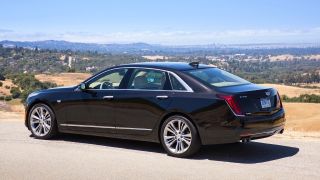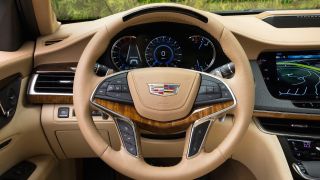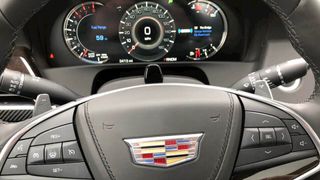Testing Cadillac Super Cruise: is this the future of hands-free driving?
Hitting the road in the 2018 Cadillac CT6

Image credit: Cadillac
When you have an open road of 130,000 miles at your disposal, it’s easy to feel like you’re just cracking the surface of a new technology.
That’s what happened recently after testing a 2018 Cadillac CT6 sedan for a week, driving along a highway during a morning commute and then all the way across an entire state for about three hours, all without using the steering wheel.
Cadillac first announced Super Cruise several years ago, and it was a shot across the bow for competitors like Tesla, Mercedes-Benz and Audi – companies that are all working on similar tech.
Tesla made the most progress until a fatal accident in 2016. Before then, it was possible to drive for long periods of time without touching the steering wheel. An update now forces drivers to hand-check to make sure they are paying attention. (Tesla owners have figured out though that they can wedge an orange or a water bottle in the steering wheel to trick the system.)

With Super Cruise, the system goes well beyond the on-board sensors that keep you centered in your lane.
Cadillac mapped out 130,000 miles of highways in the US, but in order for the system to work, you must be on a road that has a barrier between lanes, is a four-lane highway, and entrance and exit ramps (usually with an overpass).
Get daily insight, inspiration and deals in your inbox
Get the hottest deals available in your inbox plus news, reviews, opinion, analysis and more from the TechRadar team.
In our tests, we noticed Super Cruise would only activate after driving on a highway that meets those criteria after a minute or so, then disable itself a few minutes before we entered a stretch of road that didn’t meet the criteria.
“One of the benefits of Super Cruise is to reduce driver fatigue during highway commutes – especially during heavy congestion on every day commuting and on long distance trips,” says Daryl Wilson, the Lead Development Engineer for Super Cruise. “Super Cruise combines information from five cameras with a high-definition LIDAR-scanned map database and real-time corrected precision GPS to provide a robust path for the vehicle to follow.”

During one test, a small gray icon appeared to the right of the main speedometer display indicating that Super Cruise was available.
We then pressed the Super Cruise button to activate it, and took our hands off the wheel. It’s a slick, intelligent new technology that helped with the tedium of driving – you can relax a little more.
You still have to stay alert, but without your hands on the wheel, you can rest your arms and let the car drive itself.
The CT6 drove perfectly during each hands-free test, although there are a few things that are unique to the autonomous mode compared to driving a Tesla Model S.
One is that the lights on the steering wheel help you drive (or, rather, not drive). Green means Super Cruise is activated, red means there’s a warning, and blue means it’s paused.
If you want to change lanes, you activate the turn signal, then wait for the blue light to appear. This tells you that Super Cruise is pausing while you change lanes. Once you do, you wait for the light to glow blue so Super Cruise can resume. It takes some practice, honestly, but it makes sense why it works that way.

Secondly, Super Cruise is constantly monitoring whether you are paying attention; a camera points directly at you from the steering column.
In one drive, turning to look at a passenger for too long caused the system to deactivate. The lights started flashing, and we had to place our hands on the wheel after a few seconds.
In another test, turning to look to the side of the car caused the system to deactivate again. This time, the system flashed but, because we didn’t grab the wheel, it locked the system and made Super Cruise unavailable. (To use it again, you have to pull over, turn the car off for a few seconds, then start the engine again.)

These precautions also make sense. It’s a smart way to allow the driver to go hands-free for even several hours, monitoring attention level the whole time. And, it worked.
Other lane-keeping technologies, autonomous driving modes, and start and stop adaptive cruise systems sometimes feel wonky, as though a computer is in control.
Super Cruise feels natural. Some vehicles – like the Chrysler 200 – have somewhat similar tech, but the car feels like it’s moving around and adjusting itself to stay in the lane. The CT6 stayed perfectly centered.
What’s next from here? I imagine Cadillac will map out more highways and even release a patch at some point for two-lane highways and then, eventually, side streets and downtown areas.
A Cadillac representative did not confirm any other plans for additional Cadillac models to use Super Cruise, but autonomous driving will become more and more common.
Google's Waymo already uses autonomous minivans, and is picking up early riders with no driver behind the wheel. However, wider adoption of fully self-driving technology is still a ways off. For now, Super Cruise is a smart system that worked well during our entire testing period.
On The Road is TechRadar's regular look at the futuristic tech in today's hottest cars. John Brandon, a journalist who's been writing about cars for 12 years, puts a new car and its cutting-edge tech through the paces every week. One goal: To find out which new technologies will lead us to fully autonomous vehicles.
- Get one of the best dash cams for your ride
John Brandon has covered gadgets and cars for the past 12 years having published over 12,000 articles and tested nearly 8,000 products. He's nothing if not prolific. Before starting his writing career, he led an Information Design practice at a large consumer electronics retailer in the US. His hobbies include deep sea exploration, complaining about the weather, and engineering a vast multiverse conspiracy.

